Violins and antique violins for sale
Discover the collections of fascinating old violins by Corilon
For many musicians, a violin is more than just an instrument. Especially old violins with their mature, individual character are true companions in orchestra playing, chamber music and solo performance. Corilon violins online catalogue features unique antique violins for sale that inspire the serious player with their delicate workmanship, selected tonewoods and fine antique varnish. Corilon's old violin shop presents a hand-selected collection of modern and antique violins for sale suitable for students, amateurs and professionals; these attractive fullsize violins feature a wide range of different characteristics and date back to different periods.

A violin's age is not counted in years but in moments of bliss
Beginners and advanced players alike appreciate older violins for their richness in tone and as a desirable alternative with a good investment value. Discover historic old violins, antique violins, English, German, French and Italian violins online, and browse our special selections of fine antique violins, professional violins and master violins. Get personal email advice here on the purchase of the right violin.
Antique violins - exclusive and unique
A violin's age is not counted in years but in moments of bliss
For many musicians, a violin is more than just an instrument. Especially old violins with their mature, individual character are true companions in orchestra playing, chamber music and solo performance.
Professional violins for sale
We present a hand-selected collection of professional violins, fine Italian violins, French violin bows and rare instruments from other countries for sale; our carefully selected antique violins, old violas, and top-quality violin bows and other fine stringed instruments full of personality and character are competently are lovingly restored by a violin maker at our luthier workshop for violin making and restoration and made made ready to play. Buy good German violins, French and Italian violins at Corilon violins: with a return policy, a trade-in option and an optional certificate. Follow the link to browse some of the violins we have sold; information on the care, cost, maintenance and history of your student or professional violin is available in our library. Purchase violins online with confidence at Corilon - we guarantee every violin in our catalogue. Corilon violins is the best price shop in the US if you're looking to buy a violin. With a wide selection of high-quality violins for sale, we provide you with the opportunity to find the perfect instrument for your musical needs.
Finding the perfect violin at Corilon
German, French and Italian violins and master violins
Corilon violins online catalogue features a wide range of meticulously restored violins, old violins and antique violins for sale, each with its own unique history and character. Crafted by master violin makers from renowned European schools of Germany, France and Italy, these instruments have stood the test of time, resonating with rich tones and a warm, mature sound. As usually expensive and high quality handwork, old violins are passed down from generation to generation. It is generally known that an old violin sounds better than a new one. The Corilon violin shop offers user-friendly navigation and detailed information and a sound sample on each available violin to ensure you can make the best choice when you order your violin online.
"The longer an old violin is played, the more beautiful its sound grows"





























